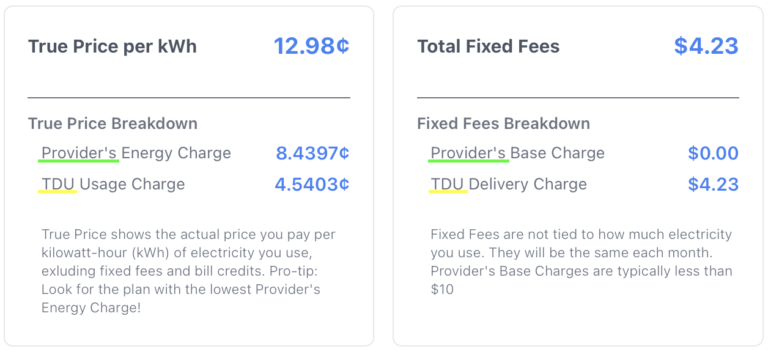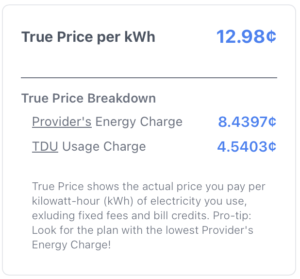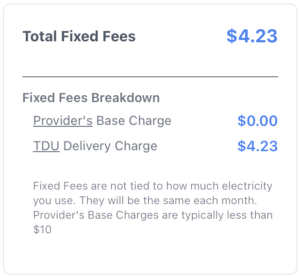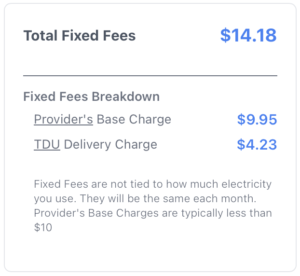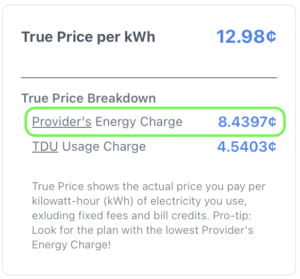Electricity Plan Pricing Guide
- Shopping for a new electricity plan can be confusing, but it doesn’t have to be. Here, we’ll explain how electricity plan pricing works in simple and easy-to-understand terms. Knowing how electricity plan pricing works will give you an edge and newfound confidence when shopping for a new electricity plan.
- Knowledge is power, but when it comes to shopping for electricity plans, knowledge is savings!
What's Covered

Overview
What are you paying for?
- Your electricity bill covers the cost of the electricity you use, as well as its delivery and maintenance. Two different companies perform these services, and the cost of both companies is accounted for in a single electricity plan.
The three price buckets
- • Usage Charges – These are based on the amount of electricity you use.
- • Fixed Fees – Recurring monthly charges regardless of the amount of electricity you use.
- • Modifiers – Often change and fluctuate each month depending on different factors defined in the contract. These can lead to inconsistent billing.
What to look for in a plan
- • Provider’s Energy Charge
- • Advertised Pricing Pattern
- • See a really low price? Like most everything else, if it seems too good to be true, it most likely is.
Use the Electricity Facts Label (EFL)
- Use the Electricity Facts Label (EFL). It’s your friend. We show you the key elements of the EFL, but we encourage our customers to review them as they provide every detail about the plan.
- Note: We use screenshots of our electricity plan cards to illustrate examples. The examples below are from the “Explore Plan Details” section of our plan cards. If you’re unfamiliar with our plan cards and want to learn more, you can do so here.
What exactly are you paying for?
- Did you know you’re paying two different companies when you pay your electric bill?
- It’s important to know what you’re paying for when you sign up for an electricity plan in Texas. It’s a common misconception that the plan’s advertised price is just for the electricity, but that’s only half the equation. The price also includes delivering electricity to your home. Buying electricity and having it delivered are two separate functions performed by two separate companies, both of which are paid for in your electricity bill.
Provider
- The company you purchase electricity from is the provider, more formally known as the Retail Electricity Provider (REP). They are responsible for buying electricity from the wholesale market and selling it directly to customers. They also manage the relationship with the customer, specifically account management, plan pricing, and billing. The provider sends you your electric bill each month.
TDU
- The utility supplier, or TDU (Transmission and Distribution Utility), delivers electricity to your home. It manages all the power lines and infrastructure needed to deliver and maintain the electricity. Their fees are included in your electricity bill and are passed through to the utility supplier from your provider.
- Customer interactions with TDUs are limited to reporting outages. Don’t know the TDU that services your area? Click here to find yours.
- You can think of the Provider as the business side of your electricity plan and the TDU as the construction side. You have a choice when it comes to which provider to use, but you don’t have a choice for TDUs. TDUs service areas of Texas, and yours is determined by where you set up electricity service.
Know the Details
- At Texas Electricity Finder, we want customers to know precisely what they’re getting with their new electricity plan. That’s why we break down the charges so that you can see where your money is going. Click ‘Explore Plan Details’ on the plan card to find these details.
- Learn more about how to read our plan cards and how they can help you navigate the Texas Electricity Market.
The Three Electricity Plan Pricing Buckets
- All cost-related items for all electricity plans can be broken down into three buckets.
Usage Charges
- These charges are multiplied by your monthly kilowatt-hours (kWh).
- • Provider’s Energy Charge
- • TDU Usage (Delivery) Charge
Fixed Fees
- These are recurring monthly charges, regardless of your electricity.
- • Provider’s Base Charge
- • TDU Delivery Charge
Modifiers
- These can make your bill fluctuate the most.
- • Bill Credits
- • Minimums
- • Time of Use
- Usage Charges are on all electricity plans. Fixed Fees apply to almost all plans. Modifiers make a plan unique and can change between providers, plans, and customers. Modifiers are where plans get unstable and confusing for some customers.
Usage Charges
- Every plan has usage charges, which is the price you pay per kWh for electricity. The charge for fixed-rate plans does not change, while the charge for variable-rate plans fluctuates each month based on the wholesale market price of electricity.
- The price per kWh includes purchasing electricity from the provider, the “Provider’s Energy Charge,” and delivery from the TDU, the “TDU Usage Charge.” We show these collectively as our True Price™, but you can view them individually in the plan details.
Provider vs TDU Charge
- The ‘Provider’s Energy Charge’ is the purchase price you pay for electricity. This value will vary between plans and providers. The ‘TDU Usage Charge’ is the same for everyone in your area and across providers. It rarely changes.
Not to get confused with the Advertised Price
- Usage Charges are not to be confused with the ‘Advertised Price’. Usage charges, or the True Price, is the price you pay for kWh before any discounts or credits are applied. The ‘Advertised Price’ includes credits, discounts, etc., and averages them over a specific kWh usage.
Fixed Fees
- Fixed Fees are regular monthly charges that are billed regardless of the amount of electricity you use.
- Fixed Fees are on most plans, but not all. As with Usage Charges, fixed fees have two components: the Provider’s Base Charge and the TDU Delivery Fee.
Provider Base Charge
- Not all plans have a Provider’s Base Charge, but for the ones that do, they are generally between $5 and $10.
TDU Delivery Charge
- As with Usage Charges, the TDU Delivery Charge is the same for everyone in your area and across providers. The only TDU that does not have a monthly delivery charge is Lubbock Power & Light. These fees range between $4 and $8.
Pro Tip
- A $10 base charge equals roughly 1¢ per kWh in the plan price. So a 13¢ with a $10 base charge would be essentially the same as a 14¢ plan with a $0 base charge at 1000 kWh.
Modifiers
- Modifiers are where things can get interesting and could cost you more than you expect. Providers create their plans and come up with creative ways to attract customers.
- Modifiers can change the billed amount calculated from your Usage Charge. As stated earlier, the Usage Charge price (True Price) does not change, but that doesn’t mean providers can’t modify the bill amount after it’s been calculated.
- Below are a few of the more common modifiers.
Bill Credits
- These are the most common modifiers because they can drastically lower an advertised price, making the plan more attractive to customers.
- To take advantage of these, you must know how much electricity you use. You need to use at least the amount of kilowatt-hours that triggers the credit, and you should stay within the trigger amount by 500 kWh. You’ll be overpaying for electricity if you’re below the trigger usage or over by more than 500 kWh.
Minimums
- This is the least amount you will be billed for electricity service in a billing cycle, regardless of how much electricity you use. Even if you use very little or no electricity, you would still owe the minimum amount.
- Plans with minimums generally have a lower per-kWh charge, which you can take advantage of during higher usage months.
Time of Use
- These are plans where the Usage Charge (True Price) does change. The per-kWh energy charge changes depending on the time of day.
- Know your usage! The estimated usage during the discounted timeframe, which the provider determines to create the advertised price, must match your usage to realize the savings.
- Free Nights and Weekends and EV Plans are popular TOU (Time of Use) plans.
Texans can save up to
$500 per year
- by switching to a new electricity plan
- explore affordable plans in your area
Things to look for in any plan
- As you navigate the Texas electricity market, here are a few things to look for in a plan. These suggestions are for customers looking for easy plans and want to avoid overpaying and surprise bills.
Providers Energy Charge
- The only difference between the various plans is the amount the providers charge. TDU charges are the same for everyone in your area and across all providers. The provider’s fees are what changes.
- The provider has many tools at their disposal to create an attractive plan. However, for most of those plans, only a small group of customers can take advantage of the special pricing, while most customers end up overpaying.
- One constant to look at across plans is the provider’s energy charge. A low “Provider’s Energy Charge” is an excellent start to finding a plan that will work great for almost all customers.
Advertised Pricing Patterns
- Check the three advertised prices for 500, 1000, and 2000 kWh. The advertised prices for a simple plan without modifiers will decrease slightly as the usage goes from 500 to 2000.
- In these two sample plans, you can see how one plan has consistent pricing, gradually decreasing from 500 to 2000 kWh, whereas the other plan fluctuates in price due to the bill credit.
- Both are good plans. You just need to find the right one for you.
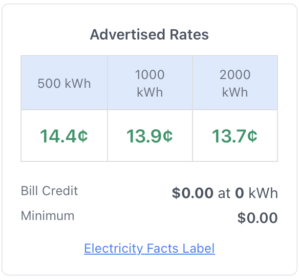
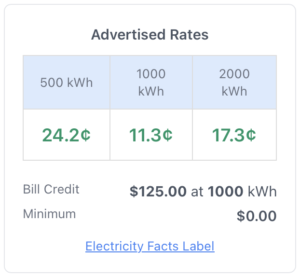
If the price is too good to be true, it just might be
- Like most things in life, if it seems too good to be true, it probably is. If you see a plan for 11¢ per kWh and all the others are around 14¢, there’s probably a reason for that. Don’t fall victim to the low-price game. It’s a tough game to win.
- The key here is to be a savvy shopper. Use the insights we covered and look for the modifiers to ensure the plan is right for you.
Term
- A lot of people skip over the term. Don’t do it; it could cost you! It’s important to know when a plan expires. Plans that require you to renew during peak months may have lower prices. Short-term plans are notorious for really low rates if they expire in June or July.
- Pay attention to long-term plans as well. Don’t lock in a rate for 36 months just because you want to avoid having to shop for electricity for three years. Getting out of that long-term plan can be costly if rates drop before the plan expires. You’ll either lose out on the savings of the lower electricity prices, or you could be subject to hefty early termination fees.
Electricity Facts Label (EFL)
- Use the Electricity Facts Label (EFL). It’s your friend. We show you key elements from the EFL in our electricity plan cards, but we encourage our customers to review the EFL as they provide every detail about the plan.
- The EFL is an essential document for consumers in Texas, designed to provide clear and straightforward information about an electricity plan. In a deregulated market, many Retail Electric Providers (REPs) offer various plans with different rates, fees, and terms. The EFL is a standardized form that helps customers compare plans apples to apples.
Components
- There are five components or sections to every EFL
- • Header – Shows the provider and the plan, as well as the TDU for the plan and the late the EFL was created or last updated.
- • Electricity Pricing – Includes all pricing details about the plan
- • Other Key Terms and Questions – Covers special terms and questions about the plan
- • Disclosure Chart – Provides additional details about the plan, such as type of plan (fixed or variable rate), term, early termination fees, etc…
- • Provider Info – Contact and other information about the provider offering the plan
- Learn more about Electricity Facts Labels here.
In closing
- There are plenty of options when it comes to electricity plans in Texas. Some are simple and straightforward, while others are complicated and confusing. Being a savvy shopper is the key to avoiding overpaying and getting into a plan that’s not right for you.
- We hope this guide is helpful in your search for a new electricity plan. At Texas Electricity Finder, we provide all the tools you need to find the perfect plan with the perfect provider.
- Start your savvy shopping today! Enter your zip code and find your new perfect electricity plan.
- If you found this helpful and think others could also benefit from reading it, share it!
Want to know more ways to Save? Check out our Tips and Ticks to be a Smart Electricity Shopper!
We gathered some of our most insightful tips to help you become a savvy shopper and avoid the pitfalls of choosing a costly plan when shopping for electricity in Texas.
Visit our Knowledge Center for more ways to become a smart electricity shopper.

